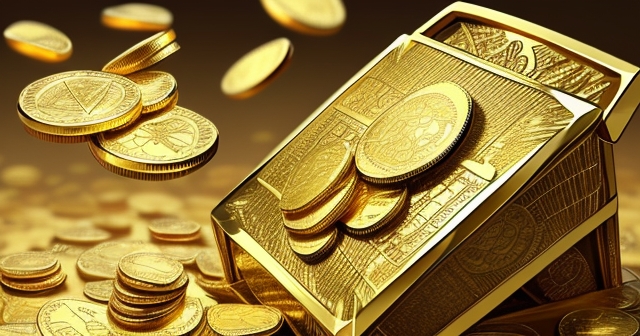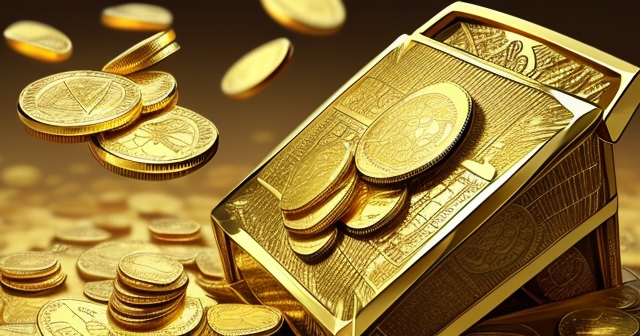What’s Driving Gold Prices? Navigating the Ascent Amidst Global Uncertainty
Gold has always held a unique place in the financial world, often seen as a timeless store of value. Recently, its performance has become particularly compelling, captivating the attention of investors worldwide. We’ve witnessed the precious metal climb to levels unprecedented in history, sparking intense debate and curiosity about its future trajectory.
Perhaps you’re an investor just starting your journey, or maybe you’re a seasoned trader looking to deepen your understanding of market dynamics. Regardless of your background, the question on many minds is simple yet profound: What’s gold going for, and more importantly, where is it headed? To answer this, we must peel back the layers and examine the powerful forces currently shaping the price of gold.
In this guide, we’ll explore the fundamental drivers propelling gold’s rally, dissect the technical indicators that offer clues about its momentum, analyze expert forecasts, and discuss how gold fits into a diversified investment portfolio. Think of this as your compass for navigating the complex landscape of gold investment in these uncertain times. Let’s embark on this journey together, demystifying the shiny allure of gold and its place in today’s markets.

Gold’s Current Altitude: A Look at Recent Peaks and Price Action
Let’s start by grounding ourselves in the present reality of gold’s price. The journey has been remarkable. In recent months, gold has not just risen; it has shattered previous records. We saw it briefly surpass the psychological barrier of $3,000 per ounce in certain markets and achieve an all-time high of $2,450.05 per ounce in May 2024, according to widely followed benchmarks. This wasn’t just a marginal increase; it represented a significant leap into uncharted territory.
As we stand today (considering the market context around June 2024), the price of gold is consolidating, trading in a relatively elevated range, recently hovering near the $2,310 to $2,330 per ounce mark. While these levels are below the absolute peak, they remain historically high. This suggests that the underlying factors driving the price upwards are still very much in play, even if short-term volatility leads to pullbacks.
Understanding this current altitude is crucial. It tells us that we are not dealing with a minor fluctuation but a potentially sustained shift in market sentiment and fundamental value perception. What, then, are these potent forces pushing gold to such heights? Let’s dive deeper into the macro landscape.
| Date | Price (per ounce) | Comment |
|---|---|---|
| May 2024 | $2,450.05 | All-time high |
| June 2024 | $2,310 – $2,330 | Consolidating |
| August 2023 | $1,900 | Pre-rally price |
Why the Safe Haven Shines: Macroeconomic Bedrock Fueling Demand
At its core, gold’s recent ascent is a story of uncertainty – global, economic, and geopolitical. When the world feels unpredictable, investors naturally seek refuge. Gold, with its history as a non-sovereign asset and a traditional store of value, becomes that safe harbor. Imagine your investment portfolio as a ship; when the seas are calm, you might seek speed and high returns. But when storms gather, you prioritize stability and safety. Gold is often the anchor in that storm.
Consider the prevailing macroeconomic environment. We face persistent concerns about inflation, potential recessionary pressures in various economies, and unpredictable performance across traditional asset classes like stocks and bonds. These factors erode confidence in paper currencies and yield-generating investments, making non-yielding assets like gold comparatively more attractive.
Geopolitical instability adds another critical layer. Conflicts in Europe and the Middle East, along with broader global power realignments, inject significant risk into the system. These events don’t just impact regional markets; they create ripple effects, increasing overall market anxiety. In such a climate, owning a tangible asset like gold, which isn’t directly tied to the fate of any single nation’s economy or government, offers a sense of security that few other assets can match. This increased demand for gold as a protective asset is a fundamental pillar supporting its high price.

The Fed’s Hand: Interest Rates, Yields, and the Dollar’s Influence
Monetary policy, particularly that of the U.S. Federal Reserve (the Fed), plays a significant, albeit sometimes complex, role in gold’s pricing. Historically, there’s an inverse relationship between gold and interest rates and the U.S. Dollar. Why is this the case?
Gold is a non-yielding asset. It doesn’t pay dividends or interest. When interest rates are high, yield-generating assets like government bonds become more attractive relative to gold. Investors can earn a guaranteed return by holding bonds, making the opportunity cost of holding gold higher. Conversely, when interest rates fall, the appeal of yield-generating assets diminishes. If rates fall significantly, especially towards zero, the opportunity cost of holding gold decreases dramatically, making it a more appealing option, particularly in an inflationary environment where bond yields might not keep pace with rising prices.
The U.S. Dollar’s strength also impacts gold. Gold is typically priced in U.S. Dollars. A stronger dollar makes gold more expensive for buyers using other currencies, potentially reducing demand. A weaker dollar has the opposite effect. Recent firmness in the U.S. Dollar, coupled with rising U.S. Treasury yields, has acted as a slight headwind for gold prices in the short term, contributing to recent pullbacks. This highlights the constant push and pull between gold’s safe-haven appeal and the attractiveness of dollar-denominated, yield-bearing assets.
Future expectations regarding the Fed’s interest rate policy are therefore paramount. If the market anticipates further rate cuts, this generally creates a tailwind for gold. If expectations shift towards higher rates or fewer cuts, it can exert downward pressure. It’s a delicate balance influenced by incoming economic data like inflation reports and employment figures.
| Interest Rate Environment | Gold Appeal | Market Reaction |
|---|---|---|
| High Interest Rates | Less Attractive | Increased Demand for Bonds |
| Low Interest Rates | More Attractive | Increased Demand for Gold |
| Zero Interest Rates | Highly Attractive | Surge in Gold Purchases |
Tariffs and Trade Wars: Market Mayhem and Gold’s Appeal
Specific government policies, particularly those related to international trade and tariffs, have recently emerged as potent catalysts for market volatility and, consequently, drivers of gold demand. When major economies engage in trade disputes, like the tariff policies seen under former President Trump and potential future actions, it creates significant uncertainty for businesses, supply chains, and the global economy. This uncertainty often triggers market sell-offs in riskier assets like stocks.
Think back to periods where tariff announcements dominated headlines. The immediate reaction in financial markets was often negative, leading to sharp declines in equity indices. This chaos and loss of confidence directly benefit safe-haven assets. As investors retreat from risk, they flock to gold, boosting its price. While there have been instances where specific exemptions for bullion from certain tariffs have led to price pullbacks (as the immediate threat to physical gold movement diminishes), the broader impact of tariff *uncertainty* on overall market sentiment remains a powerful positive driver for gold.
The prospect of renewed or escalating trade tensions continues to linger as a potential source of market disruption. Should tariff barriers rise again, or should other protectionist policies be enacted, we would likely see another surge in demand for gold as investors once more seek refuge from the resulting economic and market turbulence. This illustrates how government policy, even seemingly unrelated to precious metals, can have a profound indirect effect on gold prices by altering the broader risk landscape.

Central Banks in the Mix: A Pillar of Demand and Recent Shifts
Beyond individual investors and institutional funds, central banks around the world are major players in the gold market. They hold gold as part of their foreign reserves, viewing it as a stable asset, a hedge against currency fluctuations, and a diversification tool away from fiat currencies like the U.S. Dollar. In recent years, central banks, particularly those in emerging markets like China, have been aggressive buyers of gold, accumulating significant quantities. This consistent, large-scale buying provides a strong structural support for gold prices.
The People’s Bank of China (PBOC), for instance, has been a notable and consistent buyer. Their purchases reflect a strategic move to diversify reserves and potentially reduce reliance on the U.S. Dollar. This sustained demand from official institutions has been a key factor contributing to gold’s upward trend.
However, recent data points highlight the dynamic nature of even this demand pillar. The PBOC reportedly paused its gold buying in May 2024 after 18 consecutive months of additions. While this doesn’t necessarily signal a long-term shift away from gold, it does suggest that central banks, like other buyers, may become more price-sensitive at higher valuations. A pause or slowdown in central bank buying, especially from major players, can temporarily reduce demand momentum and contribute to price consolidation or pullbacks. We need to monitor these shifts in central bank behavior carefully as they offer valuable insights into the market’s underlying strength.
Decoding the Charts: Technical Insights for Gold
While fundamental factors like uncertainty, interest rates, and central bank buying provide the ‘why’ behind gold’s movement, technical analysis offers clues about the ‘how’ and ‘when’. By studying price charts, trading volumes, and various indicators, technical analysts attempt to identify trends, support levels (prices where buying is expected to emerge, preventing further drops), and resistance levels (prices where selling is expected to occur, limiting further gains).
Looking at recent price action (again, considering the June 2024 context), technical analysis suggests gold faces notable resistance around the $2,340 per ounce level. Overcoming this hurdle would be seen as a bullish signal, potentially opening the door for further gains towards recent highs. On the downside, technical support levels have been identified around $2,298 and the June low near $2,286.69. These are prices where technical buyers might step in.
The current technical picture, according to some analysts, suggests that the risk is skewed slightly to the downside below the $2,320 level. This means that without a strong fundamental catalyst or renewed buying pressure, gold might be more likely to test lower support levels than break through immediate resistance. A convincing break below the $2,286.69 June low would be interpreted as a significant bearish signal, potentially leading to a deeper correction.
Technical analysis is not a crystal ball, but it helps traders and investors understand market psychology and identify potential entry and exit points based on price patterns. Combined with fundamental analysis, it offers a more comprehensive view of gold’s potential path.
| Technical Level | Price | Market Insight |
|---|---|---|
| Resistance | $2,340 | Bullish signal if breached |
| Support | $2,298 | Technical buyers likely to step in |
| June Low | $2,286.69 | Critical bearish signal below this |
The Gold/Silver Ratio: A Tale of Two Metals and Market Sentiment
The relationship between gold and silver prices is often tracked through the Gold/Silver Ratio, which measures how many ounces of silver it takes to buy one ounce of gold. This ratio can provide insights into market sentiment and the relative strength of the two precious metals.
Historically, the ratio has fluctuated, but it recently hit a 5-year high above 100. This means it took over 100 ounces of silver to buy just one ounce of gold. What does such an elevated ratio tell us? It signifies that gold has been dramatically outperforming silver. This divergence is often interpreted as a sign of increased risk aversion in the market. Gold, being seen as the ultimate safe haven, tends to perform relatively better than silver, which has more industrial uses and is often seen as a ‘riskier’ commodity, during times of economic stress and uncertainty.
A very high Gold/Silver Ratio can sometimes be a contrarian signal for traders. Some view it as an indication that silver might be undervalued relative to gold and could potentially catch up if risk sentiment improves. However, as long as economic fears and uncertainty persist, the ratio is likely to remain elevated, reflecting the market’s preference for gold’s pure safe-haven qualities over silver’s dual role as both a store of value and an industrial metal.

The $4,000 Question: Expert Forecasts and Potential Catalysts
Given gold’s remarkable run, the natural question arises: Can it reach $4,000 per ounce? This milestone, once considered far-fetched by many, is now a subject of serious discussion among experts and analysts. Many forecasts suggest further upside potential, though not necessarily in a straight line, acknowledging that pullbacks are part of the journey.
Various experts predict gold could indeed reach $4,000. The timeframe for this target varies. Some analysts believe it could happen sooner rather than later, especially if current macroeconomic trends persist or accelerate. The catalysts most often cited for such a significant leap include:
-
Continued Global Uncertainty: A deepening or prolonged period of geopolitical conflict, economic instability, or market unpredictable performance could sustain and increase demand for gold as a safe haven.
-
Significant Fed Rate Cuts: A return to a low-interest-rate environment, potentially even nearing zero, especially if coupled with persistent inflation, would dramatically reduce the opportunity cost of holding gold and make it exceptionally attractive compared to low-yielding bonds.
-
Major Market Sell-offs or Recession: A significant downturn or collapse in equity or bond markets would trigger a massive flight to safety, with gold being a primary beneficiary. A recessionary environment often coincides with lower interest rates and heightened uncertainty, creating a perfect storm for gold.
-
Increased Inflation: While inflation hasn’t spiraled uncontrollably recently, persistent inflationary pressures, especially if bond yields remain low, could drive investors to gold as a traditional hedge against the erosion of purchasing power.
-
Sustained Central Bank Buying: A resumption or continuation of aggressive gold purchases by central banks globally would provide strong structural support and boost prices.
While $4,000 is the near-to-medium term focus for many, some more aggressive long-term forecasts exist, with a few experts predicting prices potentially reaching between $8,000 and $12,000 per ounce by 2028. These higher targets typically hinge on scenarios involving significant currency devaluation, persistent high inflation, or fundamental shifts in the global financial system’s architecture. However, for the current market context, the $4,000 target remains the most discussed immediate possibility.
Gold in Your Portfolio: Beyond Speculation, A Role for Stability
For many investors, gold isn’t just a speculative asset to trade on short-term price movements. It plays a crucial role in a diversified portfolio, acting primarily as a store of value and a hedge. Including gold can help reduce overall portfolio volatility, especially during periods when traditional assets like stocks and bonds are moving in tandem downwards (which often happens during crises).
Gold offers protection against potential inflation, currency devaluation, and systemic risk. It’s considered a High Quality Liquid Asset (HQLA) by institutions like the LBMA, signifying its reliability and ease of trading even in stressed market conditions. Holding physical gold, or investing through secure financial instruments backed by physical gold (like certain ETFs or allocated accounts), provides a tangible asset that is not subject to counterparty risk in the same way that paper assets are.
Viewing gold with a long-term mindset is often recommended. Its value tends to preserve purchasing power over extended periods, particularly through economic cycles. While short-term fluctuations can be significant, gold’s enduring appeal as a safe haven makes it a valuable component for investors seeking to protect wealth against unforeseen events and economic instability.
Understanding different asset classes and how they behave in varying economic conditions is key to building a resilient portfolio. If you’re exploring opportunities beyond traditional stocks and bonds, perhaps considering commodities like gold or even venturing into the world of currency trading, choosing the right platform is paramount.
If you’re considering starting forex trading or exploring more CFD products, Moneta Markets is a platform worth considering. Hailing from Australia, it offers over 1000 financial instruments, suitable for both beginners and professional traders.

Navigating Volatility: Risks and Considerations
Despite the strong fundamental drivers and bullish expert forecasts, investing in gold isn’t without its risks and complexities. Gold prices are subject to volatility, influenced by the constant flow of economic data, shifts in market sentiment, and speculative trading activity. While long-term prospects may appear bright, short-term pullbacks can be sharp and sudden.
Factors that could trigger pullbacks include:
-
Improvements in Economic Outlook: If global economic data shows unexpected strength and stability, reducing recession fears, investors might shift capital back towards riskier, yield-generating assets.
-
Hawkish Shifts in Monetary Policy: If central banks signal a faster-than-expected pace of interest rate hikes, or are less dovish than anticipated, this increases the appeal of bonds and the U.S. Dollar, pressuring gold.
-
Easing Geopolitical Tensions: A resolution or significant de-escalation of major conflicts would reduce the demand for safe-haven assets.
-
Stronger U.S. Dollar and Higher Yields: As discussed earlier, a sustained rise in the dollar or Treasury yields makes gold relatively less attractive.
-
Profit-taking: After a significant rally, some investors and traders will naturally sell to lock in gains, leading to temporary price corrections.
Furthermore, physical gold, while offering direct ownership, comes with storage and insurance costs. Investing via financial instruments like ETFs or futures involves different risks, including counterparty risk (depending on the structure) or leverage risk (in futures). Understanding these nuances is crucial. It’s essential to approach gold investment with a clear strategy, whether for long-term wealth preservation or tactical trading, and to be prepared for potential short-term price swings.
Comparing Assets: Gold Versus Yield-Bearing Investments
A common point of discussion for investors is how gold stacks up against assets that provide a regular income stream, such as bonds, dividend stocks, or even high-yield savings accounts. As we’ve touched upon, gold’s main drawback in this comparison is its lack of yield; it doesn’t pay interest or dividends. This is precisely why the level of interest rates is so critical to gold’s relative attractiveness.
In a low-interest-rate environment, the yield differential between gold and bonds narrows or even disappears, making gold’s non-yielding nature less of a disadvantage. In fact, if inflation is present, holding low-yielding bonds might result in a negative real return (your return after accounting for inflation is less than zero), while gold, though non-yielding, might appreciate in nominal terms, potentially preserving purchasing power better.
During periods of high market risk or economic stress, the primary benefit of gold isn’t its yield (or lack thereof), but its potential for capital preservation or appreciation as other assets decline. Investors may accept the absence of yield in exchange for this perceived safety and diversification benefit. Yield-bearing assets, while offering income, can suffer significant capital losses during crises.
The choice between gold and yield-bearing investments often boils down to an investor’s risk tolerance, time horizon, and outlook on the macroeconomic environment. When uncertainty is high and yields are low, gold shines. When the economy is stable and interest rates are rising, yield-bearing assets tend to be more appealing. Savvy investors understand that these asset classes play different, often complementary, roles within a diversified portfolio.

The Global Stage: How International Events Impact Gold
Gold’s market is inherently global, and its price is influenced by events spanning continents. Beyond major conflicts, localized political instability, economic crises in significant economies, or shifts in demand from key consuming nations like India and China can all have an impact. For example, harvest seasons and cultural events in India can affect jewelry demand, while economic policies and consumer trends in China influence both investment and industrial demand.
Currency movements among major trading partners also matter. While the U.S. Dollar is the primary benchmark, significant weakening or strengthening of other major currencies (like the Euro, Yen, or Yuan) against the dollar can influence global gold demand patterns. If, for instance, a major currency weakens significantly against the dollar, gold priced in that local currency becomes more expensive, potentially dampening demand from buyers in that region, while paradoxically making gold cheaper for dollar holders.
Furthermore, specific events, such as banking sector stress (like potential bank failures mentioned in market analysis) or political turmoil within major economic blocs (like the European Parliamentary election turmoil mentioned in recent reports), feed into the broader narrative of uncertainty that supports gold prices. These events reinforce the need for assets outside the traditional banking system and governmental control. Understanding this interconnectedness is vital; gold price movements are rarely isolated and are often symptomatic of deeper global economic and political currents.
Navigating these global markets, whether in gold, forex, or other instruments, requires robust tools and reliable infrastructure. When selecting a trading platform, the technology and regulatory assurances provided can make a significant difference.
When choosing a trading platform, the flexibility and technical advantages of Moneta Markets are worth mentioning. It supports major platforms like MT4, MT5, Pro Trader, combined with high-speed execution and low spread settings, providing a good trading experience.
Conclusion: Gold’s Enduring Role in an Uncertain World
As we’ve explored, the current price of gold is the result of a complex interplay of powerful forces. Global economic uncertainty, geopolitical instability, the trajectory of interest rates and the U.S. Dollar, the strategic buying behavior of central banks, and technical market dynamics all contribute to its valuation. Gold’s role as a premier safe-haven asset is not merely historical; it is being actively reinforced by the unpredictable nature of today’s world.
While the path forward will likely involve volatility and potential pullbacks, the fundamental drivers that have pushed gold to its recent record highs remain largely intact. Expert forecasts widely anticipate further growth, with the $4,000 per ounce target now firmly on the horizon, contingent on the catalysts we’ve discussed.
For you as an investor, understanding what’s gold going for means appreciating its multifaceted nature. It’s not just a metal; it’s an indicator of global stress, a hedge against risk, and a store of value across generations. Incorporating gold into your portfolio, viewed through a long-term lens, can provide valuable diversification and protection against the potential storms ahead.
Whether the market environment prompts you to consider traditional hedges like gold or explore other avenues like forex trading, equipping yourself with knowledge and reliable resources is key to making informed decisions and navigating the financial markets successfully. Remember, in a world full of variables, having a solid understanding of the assets you choose is your greatest advantage.
whats gold going forFAQ
Q:What are the primary factors influencing gold prices?
A:The primary factors include global economic uncertainty, inflation rates, interest rates set by central banks, geopolitical tensions, and demand from investors and central banks.
Q:Why do investors consider gold a safe haven asset?
A:Investors view gold as a safe haven due to its history as a store of value and its ability to maintain worth during economic downturns and inflationary pressures.
Q:How does the Gold/Silver Ratio impact investment decisions?
A:The Gold/Silver Ratio helps investors assess market sentiment and determine if silver may be undervalued compared to gold, influencing asset allocation decisions.

留言